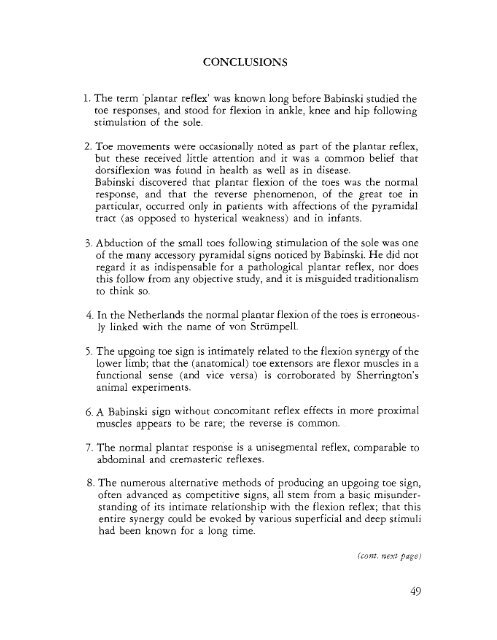You also want an ePaper? Increase the reach of your titles
YUMPU automatically turns print PDFs into web optimized ePapers that Google loves.
CONCLUSIONS<br />
1. The term 'plantar reflex' was known long before Babinski studied the<br />
toe responses, and stood for flexion in ankle, knee and hip following<br />
stimulation of the sole.<br />
2. Toe movements were occasionally noted as part of the plantar reflex,<br />
but these received little attention and it was a common belief that<br />
dorsiflexion was found in health as well as in disease.<br />
Babinski discovered that plantar flexion of the toes was the normal<br />
response, and that the reverse phenomenon, of the great toe in<br />
particular, occurred only in patients with affections of the pyramidal<br />
tract (as opposed to hysterical weakness) and in infants.<br />
3. Abduction of the small toes following stimulation of the sole was one<br />
of the many accessory pyramidal signs noticed by Babinski. He did not<br />
regard it as indispensable for a pathological plantar reflex, nor does<br />
this follow from any objective study, and it is misguided traditionalism<br />
to think so.<br />
4. In the Netherlands the normal plantar flexion of the toes is erroneously<br />
linked with the name of von Strumpell.<br />
5. The upgoing toe sign is intimately related to the flexion synergy of the<br />
lower limb; that the (anatomical) toe extensors are flexor muscles in a<br />
functional sense (and vice versa) is corroborated by Sherrington's<br />
animal experiments.<br />
6. A Babinski sign without concomitant reflex effects in more proximal<br />
muscles appears to be rare; the reverse is common.<br />
7. The normal plantar response is a unisegmental reflex, comparable to<br />
abdominal and cremasteric reflexes.<br />
8. The numerous alternative methods of producing an upgoing toe sign,<br />
often advanced as competitive signs, all stem from a basic misunderstanding<br />
of its intimate relationship with the flexion reflex; that this<br />
entire synergy could be evoked by various superficial and deep stimuli<br />
had been known for a long time.<br />
(cont. next page)<br />
49
















